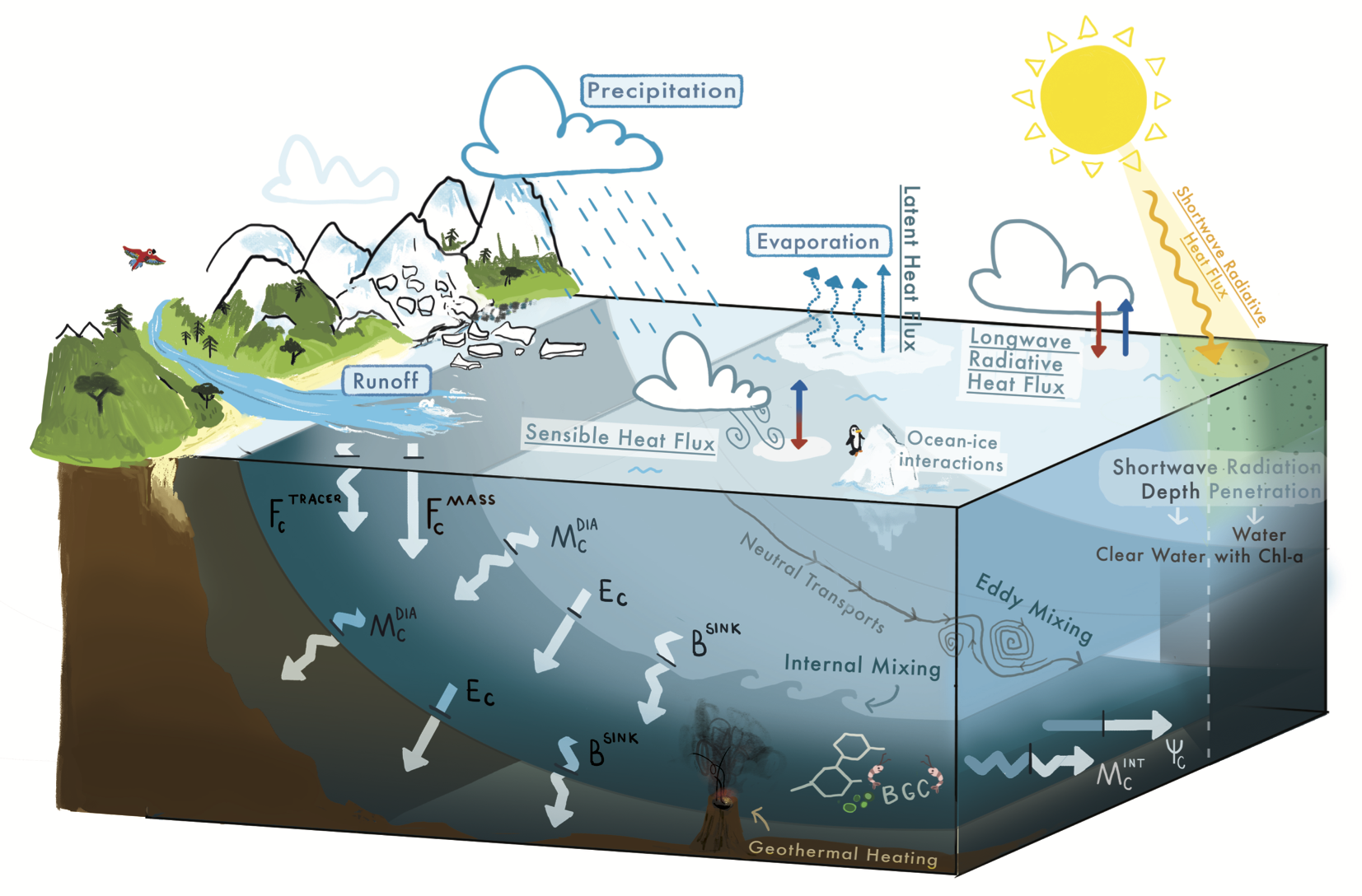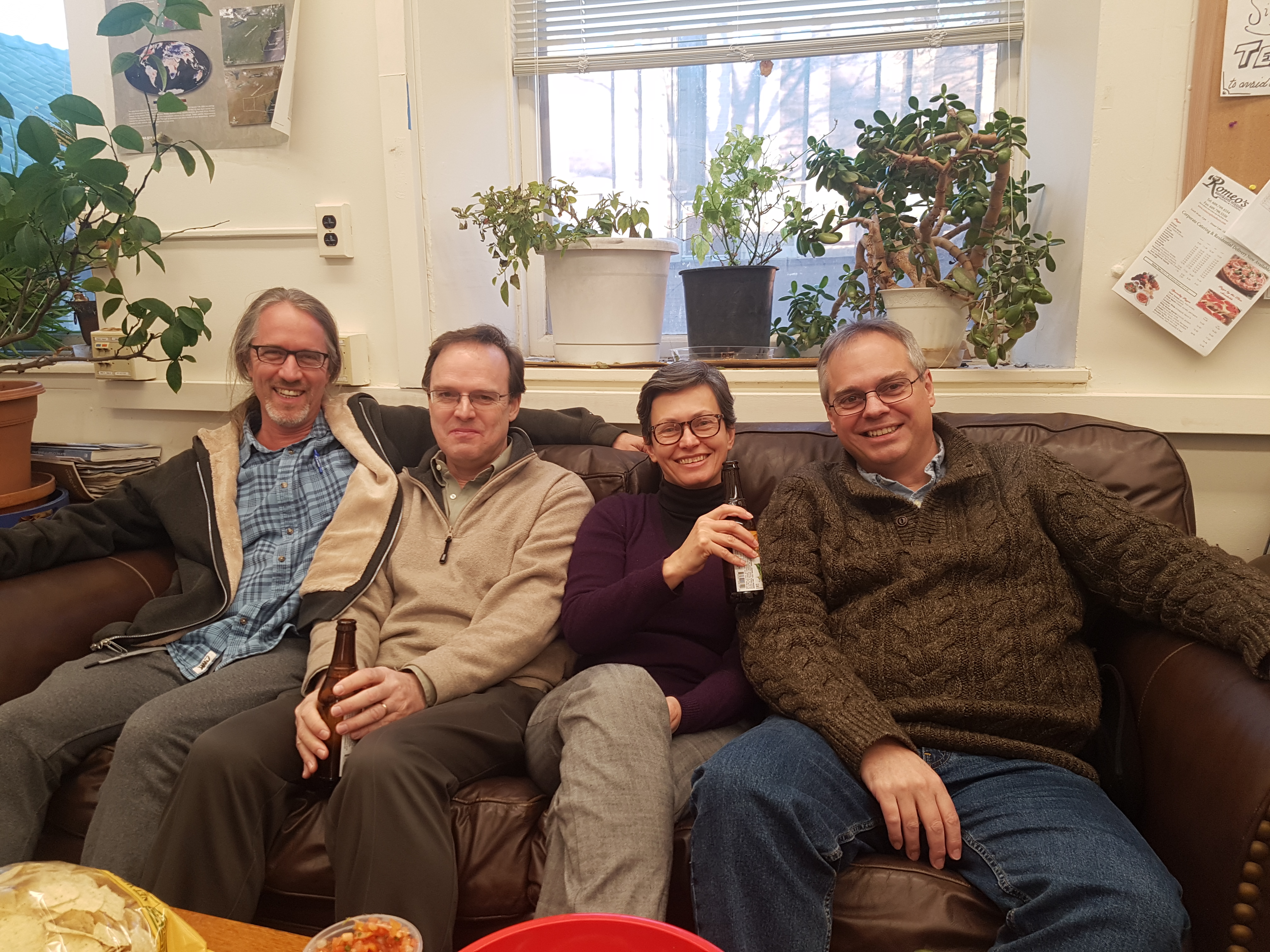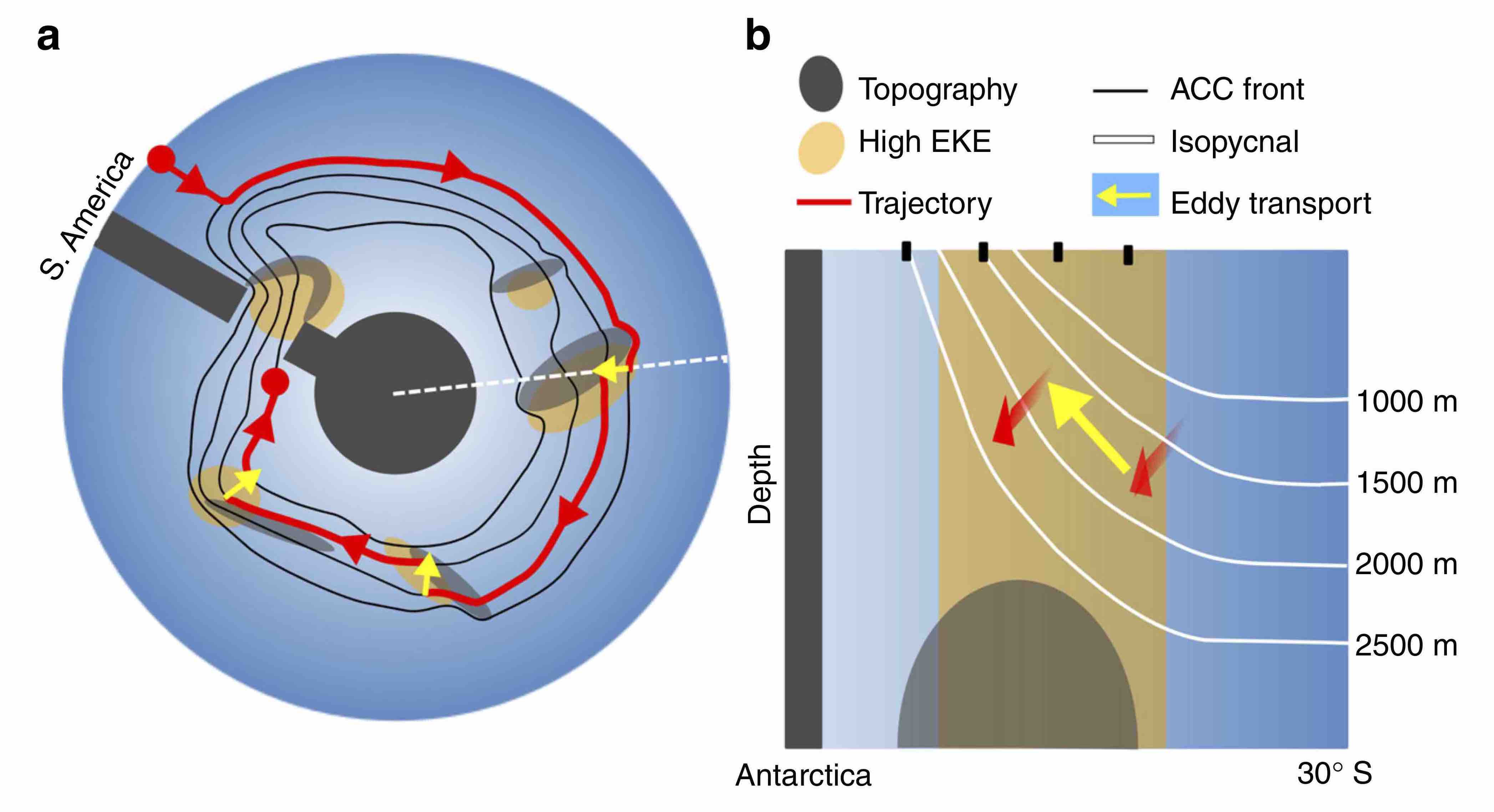Philosophy + Aims
Ocean models provide a repository for mechanistic theories of how the
ocean works, with numerical methods used to transform our mathematical
physics theories into computational tools for scientific
investigations. Mathematical physics theories and numerical methods
provide the foundation for ocean models. The practice of ocean
modeling uses numerical models as an experimental tool to help reveal
mechanisms for patterns of ocean phenomena emerging from the governing
equations (e.g., waves, instabilities, turbulence, jets, boundary
currents, overturning circulation). Models and modeling form the two
pillars of numerical and theoretical oceanography, with these pillars
supported by, and in turn supporting, observational oceanography and
laboratory studies.
Throughout my career I have endeavored to bring rigor and synthesis to
the many intellectual strands comprising the foundations of ocean
models and forming the practice of ocean modeling. This work has
spanned nearly all areas of ocean science, from ocean model algorithms
and code development, coupled model development, theoretical studies
into subgrid scale parameterizations, and formulations of experimental
protocols supporting the systematic analysis of model intercomparison
projects. This page summarizes some of this work, and offers pointers
for where research can bring further insights.
Science of Models
The science going into ocean models includes theories for how the ocean works (e.g., the equations of motion including subgrid scale parameterizations) and numerical methods for discretizing the mathematical equations. This section outlines areas where I have contributed to this science.

Model Foundations
As part of my work on ocean models foundations, I have offered both novel ideas and syntheses across a number of methods. Here are samples from this work.
- The geography of numerical mixing in a suite of global ocean models: Holmes (2021)
- The interpretation of temperature and salinity variables in numerical ocean model output, and the calculation of heat fluxes and heat content: McDougall et al (2021)
- A Primer on the Vertical Lagrangian-Remap Method in Ocean Models Based on Finite Volume Generalized Vertical Coordinates: Griffies, Adcroft, and Hallberg (2020)
- Relating the diffusive salt flux just below the ocean surface to boundary freshwater and salt fluxes: Nurser and Griffies (2019)
- Vertical resolution of baroclinic modes in global ocean models: Stewart et al (2017)
- Ocean circulation models and modelling: Griffies and Treguier (2013)
- Problems and Prospects in Large-Scale Ocean Circulation Models: Griffies et al (2010)
- Science of Ocean Models: Griffies (2009)
- Formulating the equations of an ocean model: Griffies and Adcroft (2008)
- Formulation of an ocean model for global simulations: Griffies et al (2005)
- Fundamentals of Ocean Circulation Models (book): Griffies (2004)
- Tracer conservation with an explicit free surface method for z-coordinate ocean models: Griffies et al (2001)
- Spurious diapycnal mixing associated with advection in a z-coordinate ocean model: Griffies, Pacanowski, and Hallberg (2000)
- Developmenets in Ocean Modelling: Griffies et al (2000)
Parameterizations

The ocean eddy parameterization problem is part of the larger turbulence closure problem, and it is among the most important and intellectually challenging problem in theoretical physical oceanography. It is important since eddy parameterizations, from the planetary boundary layer to the ocean interior to the bottom boundary layer, have a huge role in determining the performance of ocean models. It is challenging since it draws upon a wide variety of physical and mathematical skills. I have an ongoing interest in ocean eddy parameterization questions, and am particularly motivated by some exciting theoretical/modeling and observational studies conducted during recent years. This interest has led me to play a role in the NSF/NOAA funded Process Team on ocean transport and eddy energy. Notably, there are many unsolved questions looking for energetic students and postdocs to help unravel!
- A general-coordinate, non-local neutral diffusion operator: Shao et al (2020)
- Comparing ocean surface boundary vertical mixing schemes including Langmuir turbulence: Li et al (2019)
- The KPP boundary layer scheme for the ocean: revisiting its formulation and benchmarking one-dimensional simulations relative to LES: Van Roekel et al (2018)
- On geometrical aspects of interior ocean mixing: McDougall, Groeskamp, and Griffies (2014)
- Impacts of parameterized Langmuir turbulence and non-breaking waves on global simulations: Fan and Griffies (2014)
- A boundary-value problem for the parameterized mesoscale eddy transport: Ferrari, Griffies, Nurser, and Vallis (2010)
- Biharmonic friction with a Smagorinsky-like viscosity for use in large-scale eddy-permitting ocean models: Griffies and Hallberg (2000)
- Isoneutral diffusion in a z-coordinate ocean model: Griffies et al. (1998)
- The Gent-McWilliams skew flux: Griffies (1998)
Modular Ocean Model (MOM)
During the years 1997-2013, much of my working day consisted of
developing MOM versions 3,4, and 5
(see this document for a brief history of MOM). This work was
among the most rewarding of my career. Although I stopped focusing on
development after MOM5 in
early 2013, I remain engaged in a variety of scientific activities
that make use of this code, most notably the COSIMA (Consortium for Ocean-Sea Ice
Modelling in Australia) and the
CM2.6 project. Both projects pursue studies of global model
resolutions that admit a rich field of mesoscale eddies.
More recent efforts of ocean code development at GFDL center on MOM6, which is a project
led by my colleagues and friends Alistair Adcroft and Robert Hallberg.
My focus on MOM6 has been on its diagnostic/analysis capabilities,
with ongoing work aiming to make MOM6 as friendly to ocean analysts as
it is to algorithm developers. Quite generally, MOM6 offers many
sophisticated numerical features and physical parameterizations well
beyond MOM5. These enhancements provide ocean modelers with critical
tools needed to address a number of high profile questions such as sea
level rise and ocean heat uptake. My recent mentoring activities
involve the use of MOM6 as a tool for idealized and realistic model
simulations and analysis.


- The MOM3 Manual: Pacanowski and Griffies (2000)
- A Technical Guide to MOM4: Griffies, Harrison, Pacanowski, and Rosati (2008)
- Elements of the Modular Ocean Model (MOM): Griffies (2012)
- The GFDL global ocean and sea ice model OM4.0: model description and simulation features: Adcroft et al (2019)
Science of Modeling
When handed a numerical model, the scientist must decide how to use it for revealing phenomena (e.g., waves, turbulence, boundary currents, overturning circulation) emerging from the fundamental equations. Questions arise surrounding how to design a numerical experiment that is reproducible by others who may wish to compare/contrast their model results. And when simulation results are obtained, questions then arise concerning how to rationalize the output through analysis and interpretation. Here I summarize areas where my research efforts have contributed to help answer these questions.
CORE/OMIP
Global ocean/sea-ice models are commonly used to help understand the
mechanics of ocean variations and to directly compare to
observations. In the absence of an interactive atmospheric model, the
modeler must make decisions for how to force the ocean/sea-ice model
in a way that does not compromise on the scientific investigation.
During the period from 2000 to 2009, I worked with colleagues on the
CLIVAR Working Group for Ocean Model Development, now called the
Ocean Model
Development Panel (OMDP), to develop an experimental protocol for
running global ocean/sea-ice models. This protocol is known as the Coordinated Ocean-sea ice
Reference Experiments (CORE). The CORE protocol has become a
community standard, thus forming the basis for the
Ocean Model Intercomparison Project (OMIP) ongoing as part of CMIP6.
- Coordinated Ocean-ice Reference Experiments (COREs): Griffies et al (2009)
- OMIP contribution to CMIP6: experimental and diagnostic protocol for the physical component of the Ocean Model Intercomparison Project: Griffies et al (2016)
Analysis methods

Given a robust model, a sensible experimental design, and sufficient computing, one then moves onto questions about how to rationalize the output from the simulation. This task brings us back to fundamentals, with the associated analysis confronting us with very basic questions about the underlying fluid mechanics. Here are some papers that develop a suite of analysis methods, some of which are of use for analyzing data from both models and observations.
- The water mass transformation framework for ocean physics and biogeochemistry: Groeskamp, Griffies, et al (2019)
- Lagrangian ocean analysis: fundamentals and practices: van Sebille, Griffies, et al (2018)
- The deep ocean buoyancy budget and its temporal variability: Palter, Griffies, et al (2013)
- Physical processes that impact the evolution of global mean sea level in ocean models: Griffies and Greatbatch (2012)
